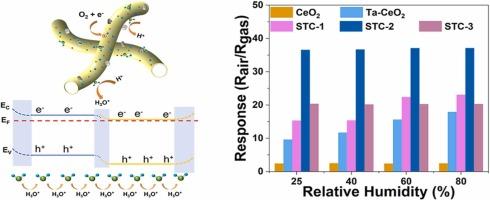Harnessing Ag-decorated electrospun Ta-doped CeO2 nanofibers for superior acetone detection with unparalleled humidity resistance
IF 8
1区 化学
Q1 CHEMISTRY, ANALYTICAL
引用次数: 0
Abstract
The imperative to detect acetone (CH3COCH3) in the absence of humidity interference is underscored by its expansive utility in environmental and healthcare contexts. To address this, a novel sensor comprising Ag-decorated Ta-doped CeO2 (STC) hollow nanofibers has been engineered through a meticulous process of electrospinning, followed by the decoration of Ag nanoparticles via UV irradiation. The fabricated STC-2 sensor (1 mol% Ag @ Ta-doped CeO2) presents a remarkable response of 36.6 to 100 ppm acetone at 170℃, 15.3-fold superior to that of its pristine CeO2 counterpart, fast response time (19.53 s), exceptional selectivity, repeatability, and long-term stability. Impressively, the STC-2 sensor maintains a considerable response of 2.0 to acetone even at a minimal level of 0.5 ppm, with the theoretical lowest of detection limit of 9.9 ppb. In addition, the STC-2 sensor is resistant to moisture, attributed to the hydrophobic Ag (110) nanoparticles and the innovative "U-shaped" groove heterojunction which forms a potential barrier between CeO2 and Ag as well as Ta2O5 and Ag. Meanwhile, density functional theory calculations affirm the STC sensors' predilection for high O2 and acetone adsorption energy while maintaining low affinity to H2O molecules. These findings herald the potential of "U-shaped" groove heterojunction in advancing humidity-resistant gas sensors.

求助全文
约1分钟内获得全文
求助全文
来源期刊

Sensors and Actuators B: Chemical
工程技术-电化学
CiteScore
14.60
自引率
11.90%
发文量
1776
审稿时长
3.2 months
期刊介绍:
Sensors & Actuators, B: Chemical is an international journal focused on the research and development of chemical transducers. It covers chemical sensors and biosensors, chemical actuators, and analytical microsystems. The journal is interdisciplinary, aiming to publish original works showcasing substantial advancements beyond the current state of the art in these fields, with practical applicability to solving meaningful analytical problems. Review articles are accepted by invitation from an Editor of the journal.
 求助内容:
求助内容: 应助结果提醒方式:
应助结果提醒方式:


